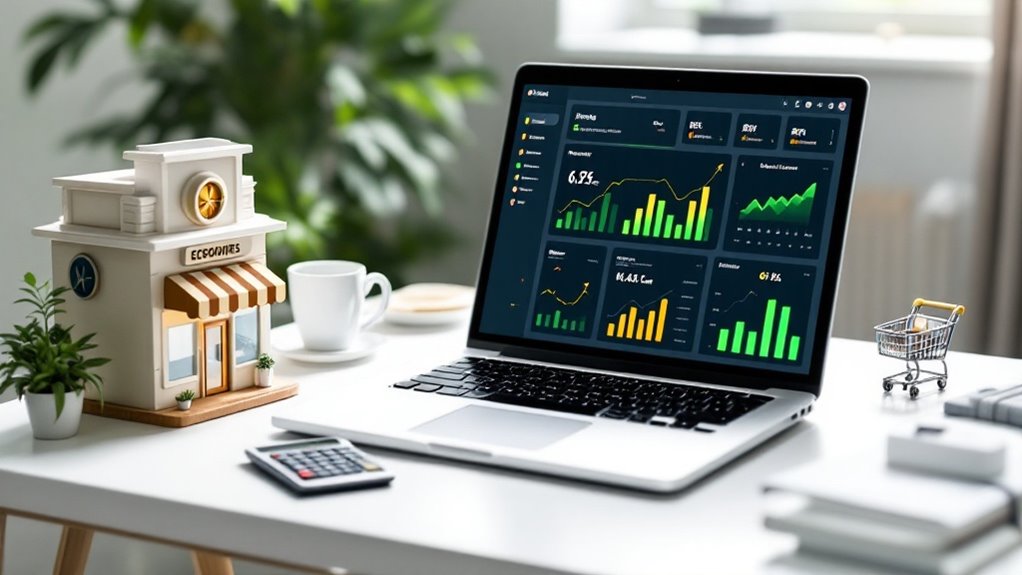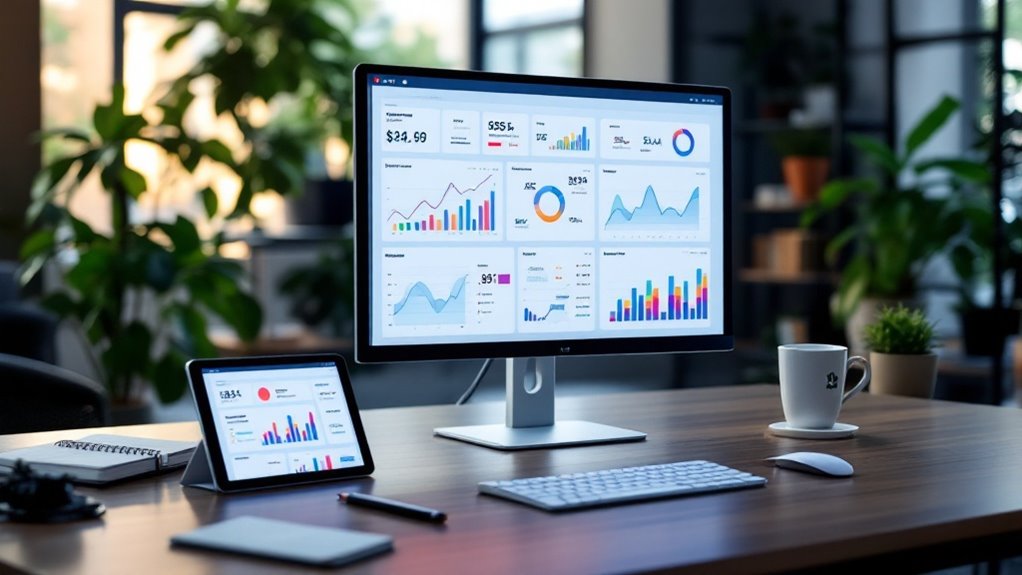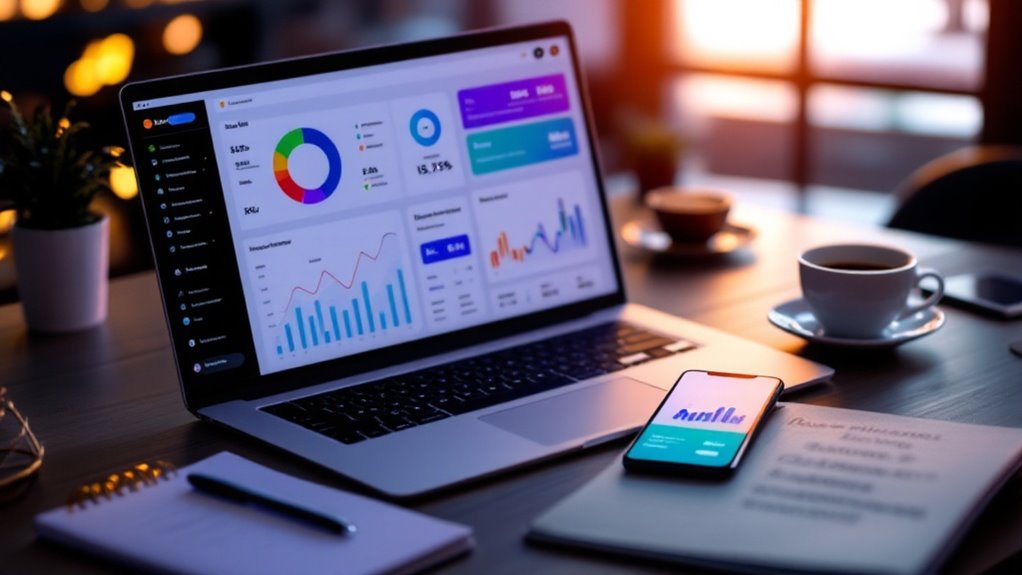Several dashboard software options stand out for small businesses seeking data visualization and analytics tools. Zoho Analytics offers budget-friendly plans starting at $24/month with extensive templates, while Tableau provides powerful charting capabilities for real-time monitoring. Google Data Studio remains a robust free option, and Microsoft Power BI delivers enterprise-level features at $9.99/user/month. For businesses prioritizing user-friendliness and affordability, Klipfolio presents an accessible solution. The key lies in understanding which features align with specific business requirements.
Quick Overview
- Zoho Analytics offers affordable pricing starting at $24/month with extensive pre-built templates ideal for small business budgets.
- Google Data Studio provides a free yet powerful dashboard solution perfect for small businesses with limited financial resources.
- Microsoft Power BI delivers enterprise-level features at $9.99/user/month, making advanced analytics accessible to growing companies.
- Klipfolio combines user-friendly interfaces with affordable pricing, making it suitable for small businesses without technical expertise.
- DashboardFox’s one-time payment model eliminates recurring costs while providing comprehensive reporting tools for small business needs.
What Makes a Great Business Dashboard Software

Successful business dashboard software consistently delivers five essential elements that transform raw data into actionable insights.
First, real-time processing capabilities guarantee timely information and predictive analytics for proactive decision-making. Second, customization features allow businesses to create branded visualizations and tailored templates that meet specific departmental needs.
Third, effective consolidation brings all key metrics into a centralized hub with multiple tabs for organized viewing. Fourth, automation streamlines workflows through scheduled reports, smart alerts, and template-based setups. Small businesses can leverage pre-built templates to quickly create professional dashboards without extensive technical expertise.
Finally, robust data visualization tools enable compelling storytelling through interactive charts, color-coded elements, and shareable dashboards.
These core features work together to provide small businesses with thorough data management solutions that are both powerful and user-friendly, supporting growth and informed decision-making across all levels of the organization.
Top Dashboard Software Options for Small Companies
Small business owners searching for the right dashboard software have several compelling options in today’s market. Sisense stands out for data-driven decision-making with its advanced analytics and machine learning capabilities, while Zoho Analytics offers cost-effective solutions with extensive pre-built templates. These solutions enable businesses to achieve competitive advantage through real-time data analysis and strategic planning capabilities.
For businesses prioritizing visualization, Tableau delivers powerful charting tools and real-time monitoring features. Domo excels in live data updates and team collaboration, making it ideal for companies needing instant insights. Klipfolio rounds out the top options with its user-friendly approach and affordable pricing structure.
Each platform brings unique strengths:
- Sisense: Advanced analytics and customization
- Zoho Analytics: Budget-friendly with robust templates
- Tableau: Superior visualization capabilities
- Domo: Real-time monitoring and collaboration
- Klipfolio: Simplicity and affordability
Essential Features Every Dashboard Tool Should Have

Selecting an effective dashboard tool requires careful evaluation of essential features that drive business intelligence and data visualization. Modern dashboard solutions must include five core capabilities. Cost-effectiveness through optimized performance tracking helps identify operational inefficiencies and reduce unnecessary expenses.
Choosing the right dashboard solution demands strategic assessment of key features that power data-driven decision-making in today’s business landscape.
- Seamless integration with various data sources, including CRMs, ERPs, and databases, guaranteeing smooth data flow across platforms.
- Customization options featuring drag-and-drop functionality and industry-specific templates that adapt to unique business needs.
- Real-time data processing with instant updates and alerts to support quick decision-making.
- Intuitive visualization tools offering interactive charts, graphs, and responsive designs that work across all devices.
- Scalable collaboration features enabling secure sharing, role-based access, and version control.
These fundamental elements guarantee that small businesses can effectively monitor, analyze, and act on their data while maintaining flexibility for future growth.
Cost Analysis and Budget-Friendly Choices
Three key factors drive the cost analysis of dashboard software: initial investment, ongoing expenses, and scalability potential. For budget-conscious small businesses, several cost-effective options stand out in today’s market.
Free and low-cost solutions like Google Data Studio and Zoho Analytics (starting at $24/month) offer robust features without breaking the bank. Companies seeking to avoid recurring fees can consider one-time payment options like DashboardFox, which provides perpetual licensing. For growing businesses, pay-as-you-go models from providers like Microsoft Power BI ($9.99/user/month) and Domo ($30/user/month) offer flexibility and scalability. Each platform includes data source connectors that integrate seamlessly with popular business applications and databases.
When evaluating costs, businesses should consider not just the price tag but also factors like ease of use, training requirements, and integration capabilities that affect total ownership costs.
Selecting the Right Dashboard Solution for Your Business Needs

With a clear understanding of dashboard software costs, businesses can focus on finding the perfect match for their operational requirements. When evaluating potential solutions, organizations should consider key factors that align with their specific needs and growth trajectory.
Integration capabilities should match existing software ecosystems, guaranteeing seamless data flow between CRM, ERP, and other business tools. Customization options need to support industry-specific KPIs and reporting requirements, with flexible templates and branding features. Real-time updates ensure immediate access to critical business metrics for timely decision-making. User-friendliness must balance powerful features with intuitive interfaces, empowering team members to create and modify dashboards independently.
The selection process requires careful evaluation of scalability potential and vendor support quality. Small businesses should prioritize solutions that offer thorough documentation, reliable customer service, and regular updates. This approach guarantees that the chosen dashboard software can grow alongside the organization while maintaining top-tier performance.
Frequently Asked Questions
How Long Does It Typically Take to Implement Dashboard Software Successfully?
Dashboard software implementation typically takes 5-15 hours for basic setups, while more complex systems require 20-40 hours. Factors affecting the timeline include data source complexity, customization needs, and user training requirements.
Pre-built templates can reduce setup time by up to 50%. Post-implementation fine-tuning usually adds 2-8 hours, with ongoing maintenance requiring 2-5 hours monthly. Cloud-hosted solutions generally offer faster deployment than on-premise options.
Can Multiple Team Members Work on Creating Dashboards Simultaneously?
Like a well-orchestrated symphony, modern dashboard software enables multiple team members to collaborate seamlessly in real-time. Most platforms, including Smartsheet, Power BI, and Tableau, support simultaneous editing with role-based access controls to prevent conflicts.
Team members can work together on different dashboard elements, while integrated communication tools and version tracking guarantee smooth collaboration. However, some platforms may require specific licenses for full editing capabilities.
What Happens to My Data if I Switch Dashboard Software Providers?
When switching dashboard software providers, data handling typically follows several key steps. Users should first export their existing data using available tools like CSV downloads or API extractions. Most providers allow a specific timeframe for data retrieval before termination.
After switching, the old provider usually deletes the data according to their retention policies. It’s vital to verify data compatibility with the new system and maintain backups during migration to prevent loss or corruption.
Are There Industry-Specific Dashboard Templates Available for My Business Sector?
Like a tailored suit for your data needs, industry-specific dashboard templates are readily available across various sectors.
The background information confirms extensive template options for marketing, healthcare, sales, and operations. Most dashboard providers offer pre-built templates designed for specific industries, complete with relevant KPIs and metrics. These templates can be customized further to match unique business requirements while maintaining industry best practices and standard reporting formats.
How Often Should Dashboard Layouts and Metrics Be Updated for Optimal Performance?
Dashboard updates should follow a structured timeline based on metric types. Critical metrics, like sales and finances, require real-time or daily updates, while operational metrics can be refreshed monthly.
Layout reviews should occur quarterly to verify a structured data presentation.
Best practices include:
- Daily/Weekly: High-variability metrics (sales, marketing)
- Monthly: Operational and employee performance data
- Quarterly: Strategic KPIs and layout refinement
- Annually: Long-term growth metrics and visual display updates
Conclusion
Choosing the right dashboard software is like selecting the perfect control panel for your business cockpit – it needs to match your specific requirements and goals. After evaluating features, costs, and compatibility, small businesses should prioritize solutions that offer scalability, user-friendly interfaces, and essential data visualization tools. By carefully considering the options presented and aligning them with business objectives, companies can make an informed decision that drives growth and efficiency.








